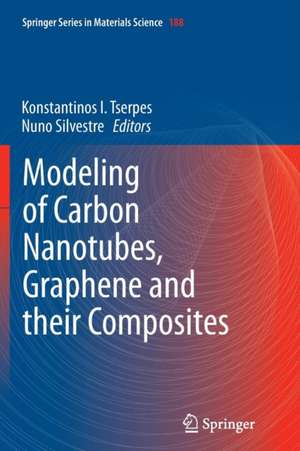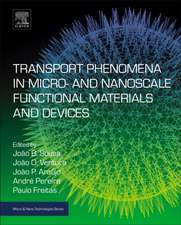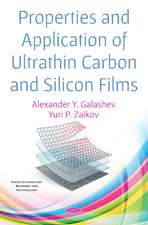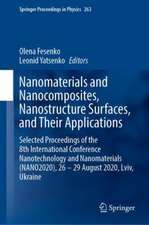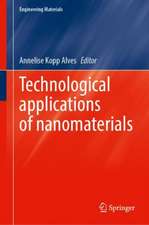Modeling of Carbon Nanotubes, Graphene and their Composites: Springer Series in Materials Science, cartea 188
Editat de Konstantinos I. Tserpes, Nuno Silvestreen Limba Engleză Paperback – 23 aug 2016
| Toate formatele și edițiile | Preț | Express |
|---|---|---|
| Paperback (1) | 642.83 lei 6-8 săpt. | |
| Springer International Publishing – 23 aug 2016 | 642.83 lei 6-8 săpt. | |
| Hardback (1) | 645.79 lei 6-8 săpt. | |
| Springer International Publishing – 28 oct 2013 | 645.79 lei 6-8 săpt. |
Din seria Springer Series in Materials Science
- 18%
 Preț: 1820.22 lei
Preț: 1820.22 lei - 18%
 Preț: 776.09 lei
Preț: 776.09 lei - 24%
 Preț: 689.69 lei
Preț: 689.69 lei - 18%
 Preț: 968.96 lei
Preț: 968.96 lei - 20%
 Preț: 568.95 lei
Preț: 568.95 lei - 18%
 Preț: 953.65 lei
Preț: 953.65 lei - 18%
 Preț: 902.36 lei
Preț: 902.36 lei - 18%
 Preț: 953.65 lei
Preț: 953.65 lei - 20%
 Preț: 948.42 lei
Preț: 948.42 lei - 18%
 Preț: 1143.07 lei
Preț: 1143.07 lei - 18%
 Preț: 1111.53 lei
Preț: 1111.53 lei - 18%
 Preț: 1103.62 lei
Preț: 1103.62 lei - 18%
 Preț: 1225.94 lei
Preț: 1225.94 lei -
 Preț: 473.91 lei
Preț: 473.91 lei - 18%
 Preț: 782.42 lei
Preț: 782.42 lei -
 Preț: 433.47 lei
Preț: 433.47 lei - 18%
 Preț: 1116.40 lei
Preț: 1116.40 lei - 18%
 Preț: 946.24 lei
Preț: 946.24 lei - 18%
 Preț: 945.20 lei
Preț: 945.20 lei - 18%
 Preț: 1114.21 lei
Preț: 1114.21 lei - 15%
 Preț: 641.20 lei
Preț: 641.20 lei - 18%
 Preț: 958.56 lei
Preț: 958.56 lei - 18%
 Preț: 1224.36 lei
Preț: 1224.36 lei - 15%
 Preț: 644.82 lei
Preț: 644.82 lei - 24%
 Preț: 833.45 lei
Preț: 833.45 lei - 24%
 Preț: 1060.36 lei
Preț: 1060.36 lei - 18%
 Preț: 964.10 lei
Preț: 964.10 lei - 18%
 Preț: 1224.36 lei
Preț: 1224.36 lei - 18%
 Preț: 1221.20 lei
Preț: 1221.20 lei - 18%
 Preț: 946.87 lei
Preț: 946.87 lei - 18%
 Preț: 1836.92 lei
Preț: 1836.92 lei - 15%
 Preț: 643.34 lei
Preț: 643.34 lei - 18%
 Preț: 1246.32 lei
Preț: 1246.32 lei - 18%
 Preț: 956.81 lei
Preț: 956.81 lei - 18%
 Preț: 953.52 lei
Preț: 953.52 lei - 15%
 Preț: 637.59 lei
Preț: 637.59 lei
Preț: 642.83 lei
Preț vechi: 756.27 lei
-15% Nou
Puncte Express: 964
Preț estimativ în valută:
123.02€ • 127.96$ • 101.56£
123.02€ • 127.96$ • 101.56£
Carte tipărită la comandă
Livrare economică 14-28 aprilie
Preluare comenzi: 021 569.72.76
Specificații
ISBN-13: 9783319343204
ISBN-10: 3319343203
Pagini: 344
Ilustrații: XII, 332 p. 177 illus., 43 illus. in color.
Dimensiuni: 155 x 235 x 18 mm
Greutate: 0.49 kg
Ediția:Softcover reprint of the original 1st ed. 2014
Editura: Springer International Publishing
Colecția Springer
Seria Springer Series in Materials Science
Locul publicării:Cham, Switzerland
ISBN-10: 3319343203
Pagini: 344
Ilustrații: XII, 332 p. 177 illus., 43 illus. in color.
Dimensiuni: 155 x 235 x 18 mm
Greutate: 0.49 kg
Ediția:Softcover reprint of the original 1st ed. 2014
Editura: Springer International Publishing
Colecția Springer
Seria Springer Series in Materials Science
Locul publicării:Cham, Switzerland
Cuprins
Preface.- 1 Improved mechanical performance of CNTs and CNT fibres in nanocomposites through inter-wall and inter-tube coupling.- 2 A Review on the Application of Nonlocal Elastic Models in Modeling of Carbon Nanotubes and Graphenes.- 3 A heterogeneous discrete approach of interfacial effects on multi-scale modelling of carbon nanotube and graphene based composites.- 4 Effect of Covalent Functionalization on Young’s Modulus of a Single-Wall Carbon Nanotube.- 5 Multiscale Modeling of Multifunctional Fuzzy Fibers based on Multi-Walled Carbon Nanotubes.- 6 Geometry-property relation in corrugated nanocarbon cylinders.- 7 Prediction of Mechanical Properties of CNT Based Composites Using Multi-scale Modeling and Stochastic Analysis.- 8 Molecular Dynamics Simulation and Continuum Shell Model for Buckling Analysis of Carbon Nanotubes.- 9 Influence of Bond Kinematics on the Rupture of Non-Chiral CNTs under Stretching-Twisting.- 10 Finite Element Modeling of the Tensile Behavior of Carbon Nanotubes, Graphene and Their Composites.
Notă biografică
Konstantinos I. Tserpes is a Mechanical Engineer with a Ph.D. in Strength Prediction of Composite Materials. Currently, he is a Lecturer of Strength of Materials at the Department of Mechanical Engineering & Aeronautics, University of Patras, Greece. His research interests are in the areas of Strength of Composite Materials, Strength of Bonded and Bolted Joints, Mechanical Behavior of Carbon Nanotubes, Graphene and Nano-Reinforced Composites, Multi-scale Analysis of Materials and Structural Parts, Development of Methodologies for Relating Data from Non-destructive Testing with Numerical Strength Prediction Models as well as Strength Prediction of Corroded Aluminum Parts. He has published 1 chapter in a book, more than 30 papers in journals and more than 40 papers in Conference proceedings. He has 14 years of research experience in the area of aeronautical structures gathered through participation in national and international research projects.
Nuno Silvestre is Associate Professor at the Department of Mechanical Engineering of IST – University of Lisbon, Portugal. He holds a PhD degree in Civil Engineering and has more than 20 years of experience in teaching, researching and consulting. His research interests include Nanomechanics, Simulation at Nanoscale, Behaviour of Thin-walled Structures, Nonlinear Solid Mechanics and Numerical Analysis of Structures, Structural Stability and Dynamics, and Design of Steel and FRP Composite Structures. He has more than 70 journal publications in peer reviewed journals and about 200 communications in international conferences. Professor Silvestre participated in several funded R&D projects, supervised several PhD and MSc students and received many awards from international and national institutions in recognition for his scientific achievements. He is also an esteemed member of several scientific and management committees, member of 7 editorial boards of international journals, and also areferee to more than 30 journals.
https://fenix.ist.utl.pt/homepage/ist13506
http://www.researcherid.com/rid/A-5644-2010
http://scholar.google.pt/citations?user=mgXXcU0AAAAJ&hl=pt-PT
Nuno Silvestre is Associate Professor at the Department of Mechanical Engineering of IST – University of Lisbon, Portugal. He holds a PhD degree in Civil Engineering and has more than 20 years of experience in teaching, researching and consulting. His research interests include Nanomechanics, Simulation at Nanoscale, Behaviour of Thin-walled Structures, Nonlinear Solid Mechanics and Numerical Analysis of Structures, Structural Stability and Dynamics, and Design of Steel and FRP Composite Structures. He has more than 70 journal publications in peer reviewed journals and about 200 communications in international conferences. Professor Silvestre participated in several funded R&D projects, supervised several PhD and MSc students and received many awards from international and national institutions in recognition for his scientific achievements. He is also an esteemed member of several scientific and management committees, member of 7 editorial boards of international journals, and also areferee to more than 30 journals.
https://fenix.ist.utl.pt/homepage/ist13506
http://www.researcherid.com/rid/A-5644-2010
http://scholar.google.pt/citations?user=mgXXcU0AAAAJ&hl=pt-PT
Textul de pe ultima copertă
This book contains ten chapters, authored by world experts in the field of simulation at nano-scale and aims to demonstrate the potentialities of computational techniques to model the mechanical behavior of nano-materials, such as carbon nanotubes, graphene and their composites. A large part of the research currently being conducted in the fields of materials science and engineering mechanics is devoted to carbon nanotubes, graphene and their applications. In this process, computational modeling is a very attractive research tool due to the difficulties in manufacturing and testing of nano-materials. Both atomistic modeling methods, such as molecular mechanics and molecular dynamics, and continuum modeling methods are being intensively used. Continuum modeling offers significant advantages over atomistic modeling such as the reduced computational effort, the capability of modeling complex structures and bridging different analysis scales, thus enabling modeling from the nano- to the macro-scale. On the other hand, atomistic modeling is very accurate and can provide detailed information about the effects of material structure such as the interfaces and functionalization.
Caracteristici
Presents cutting edge research on the continuum modeling of carbon nanomaterials Provides perspective over the advantages and disadvantages of continuum methods Represents an excellent starting point for researchers entering the field
